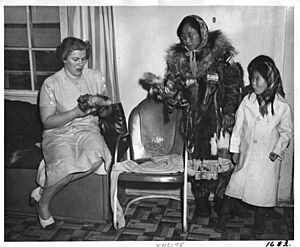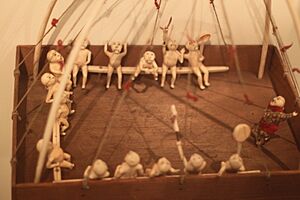Yup'ik doll facts for kids
A Yup'ik doll is a special type of traditional doll made by the Yup'ik people in southwestern Alaska. These dolls are known by different names in the Yup'ik language, like yugaq or yuguaq. They are also sometimes called Cup'ik dolls or Cup'ig dolls depending on the specific Yup'ik dialect spoken.
Yup'ik dolls are usually dressed in traditional Yup'ik clothing, like tiny parkas, which are coats designed to keep people warm in cold weather. These clothes are often made from natural materials found in their environment. The dolls themselves are typically made from wood, bone, or walrus ivory. They can range in size from just one inch to over a foot tall.
Sometimes, you can tell if a doll is male or female. Male dolls might have small ivory pieces called labrets in their lower lip. Female dolls often have special chin tattoos. In the past, it was common for a family of five dolls to be made together: a father, a mother, a son, a daughter, and a baby.
What Are Yup'ik Dolls?
Yup'ik dolls are a unique part of the culture of the Yup'ik people. These dolls are not just toys; they also have cultural importance. They show how people dressed and lived in the past.
The dolls are carefully crafted, often showing great detail in their faces and clothing. They represent the people who made them and their way of life.
Different Kinds of Dolls
Dolls made by Yup'ik people, as well as by other groups like the Siberian Yupik and Iñupiaq people in Alaska, are sometimes called Eskimo dolls. You can often tell the difference between a Yup'ik doll and an Iñupiaq doll by looking closely at their faces.
Yup'ik dolls often have a clear brow line that looks like two crescent moons joined by the nose. Their mouths also tend to be shaped like a crescent. Iñupiaq dolls, on the other hand, usually don't have this brow line. They might have more noticeable noses and very small eyes. Their mouths are often small and straight.
How Yup'ik Dolls Look
Most Yup'ik dolls have round heads made of wood, walrus ivory, or bone. Their eyes and mouths are often oval-shaped. They usually have short necks and solid bodies. Their arms are often carved as part of the body, not separated from it.
Female dolls often have tattoos on their chins, just like real Yup'ik women did. Other decorations, like hairstyles, nose piercings, or earrings, were shown using hair or beads placed in the right spots. Some dolls even wore tiny bracelets and necklaces made of beads. Male dolls often had labrets, which are small ornaments worn in the lip, made from beads or pieces of beads.
Some women in southwestern Alaska also make dolls from coiled grass. This is a special skill, similar to how they make coiled grass baskets in the Yukon-Kuskokwim Delta area.
Uses of Yup'ik Dolls
Yup'ik dolls were used for different purposes, not just for play. Some human-like figures were used by shamans, who were spiritual leaders in the community. Along the lower Yukon River, Yup'ik and Athabaskan shamans would sometimes hang wooden figures in trees. They believed these figures could help them predict where to find animals for hunting.
Dolls also played a role in the lives of Yup'ik girls as they grew up. For example, there was a strict rule that dolls should not be taken outside during the winter. It was believed that breaking this rule, or breaking a doll, could bring endless cold weather and storms. This shows how important dolls were in their daily lives and beliefs.




